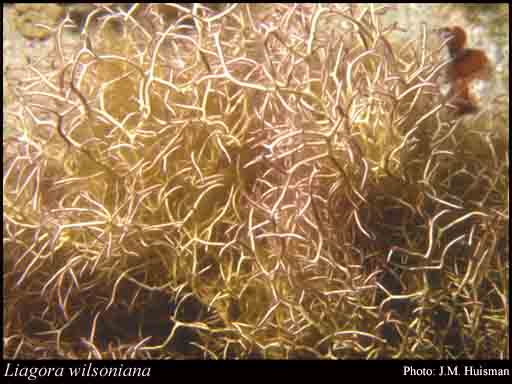- Reference
- Notizbl.Königl.Bot.Gart.Berlin 269 (1912)
- Conservation Code
- Not threatened
- Naturalised Status
- Native to Western Australia
- Name Status
- Current

Scientific Description
Habit and structure. Thallus (gametophyte) brownish red with a grey calcareous cover but often mucilaginous, moderately to heavily calcified, 5–15 cm high, with one to numerous terete axes; axes subdichotomously branched at fairly long intervals (2–5 cm), more closely dichotomous near the apices, clothed with short lateral branches throughout their length but which are often lost near the base of the thallus; laterals 0.5–1.5(–3) cm long, simple to subdichotomously branched a few times; axes 1–2 mm in diameter below, laterals 0.3–0.6(–1) mm in diameter. Holdfast discoid, 1–5 mm across; epilithic. Structure of a medulla of filaments of long cells, mostly 10–12 µm in diameter near apices, becoming 40–50 µm in diameter in older parts, interspersed with slenderer rhizoids, and a cortex 150–250 µm broad, often lost from oldest parts of thallus, consisting of subdichotomously branched filaments [7–11(–14) µm in diameter] of ovoid cells commonly highly vacuolate, branched every 1–2 cells in young laterals, often less branched on older parts of thallus; filaments on young branches strongly moniliform, less so on older parts of thallus; central cells L/D 1.5–2.5(–3), shorter near apices of filaments and longer near the base; basal cells of filaments producing rhizoids; rhodoplasts stellate to reticulate, with a central pyrenoid; hairs present on terminal cortical cells near branch apices. Tetrasporophyte unknown.
Reproduction. Sexual thalli dioecious. Carpogonial branches curved, lateral on basal to mid cells of cortical filaments, 3- or 4-celled with a conical carpogonium. Zygote dividing more-or-less transversely once or rarely twice, the upper cell developing erect branched gonimoblast filaments forming a dense, hemispherical carposporophyte (100–150 µm across in surface view) with terminal ovoid carposporangia 12–20 µm in length and 6–10 µm in diameter. Pit-connections of the carpogonial branch broadening as the carposporophyte develops, ultimately forming a distinct fusion cell involving also the lower gonimoblast cells and sometimes the supporting cell. Sterile filaments develop immediately after fertilization from cortical cells adjacent to the supporting cell, forming a prominent loose mass around the old carpogonial branch; these sterile filaments develop a prominent involucre of slender, curved filaments of elongate cells around the carposporophyte, remaining distinct from the cortical filaments; involucral filaments usually branched both near their bases and apices. Spermatangia produced abundantly in capitate clusters at apices of cortical filaments; terminal cortical cells cutting off from their upper ends several elongate spermatangial initials, each forming several spermatangia; spermatangia ovoid, 2–3 µm in diameter.
Distribution.W. Aust. (probably near Perth, possibly as far N as Dongara) around southern Australia to Walkerville, Vic., not known from Tas.
[After Womersley, Mar. Benthic Fl. Southern Australia IIIA: 98–99 (1994)]
Distribution
- IBRA Regions
- Jarrah Forest.
- IBRA Subregions
- Southern Jarrah Forest.
- IMCRA Regions
- Leeuwin-Naturaliste.
- Local Government Areas (LGAs)
- Albany, Augusta Margaret River, Cockburn.